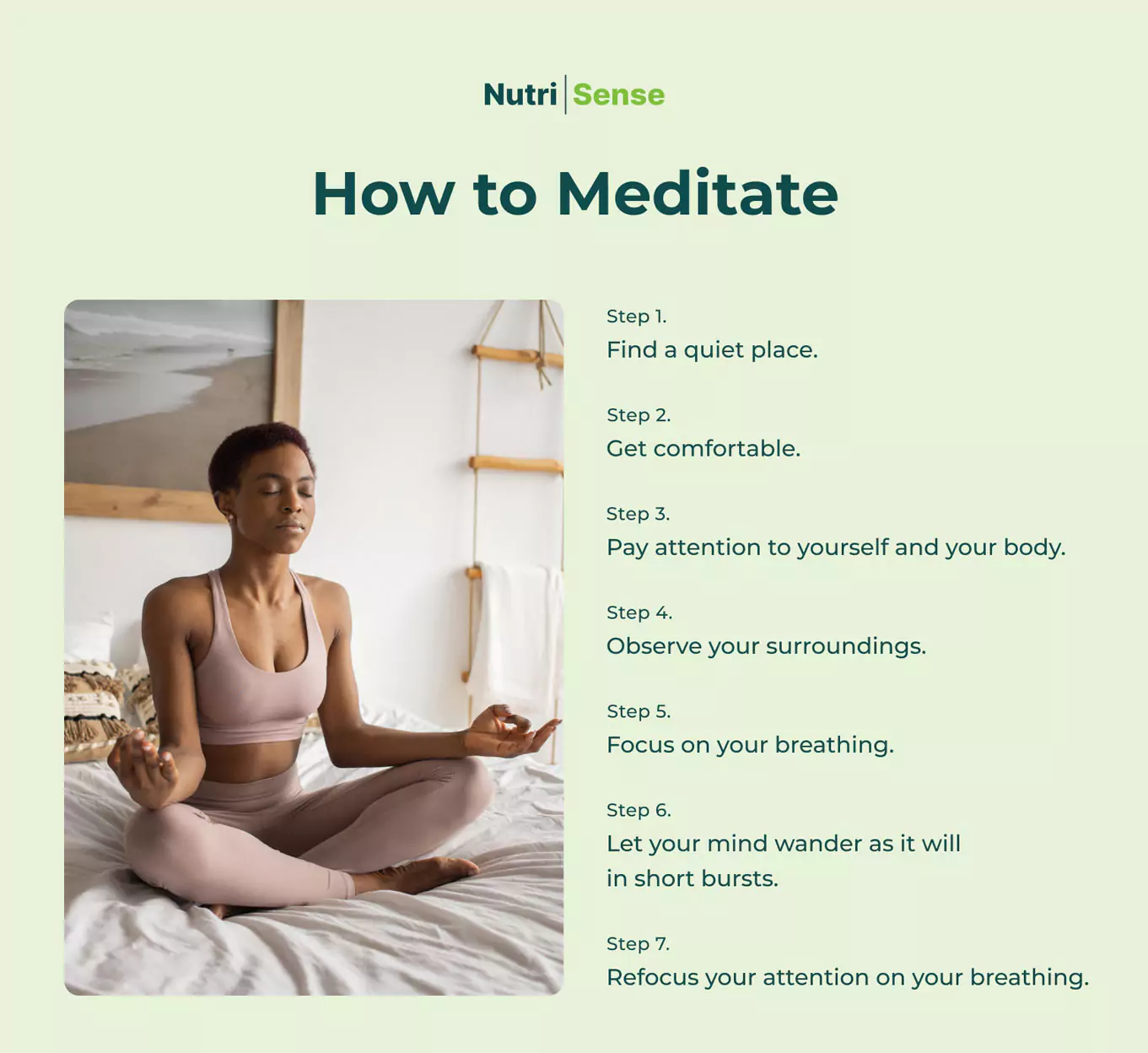A Quick Look at Meditation and Blood Glucose

Key Takeways
Meditation has become a popular way to reduce stress and promote wellbeing. It’s a practice that allows you to connect with your inner self and has roots in religious and therapeutic purposes.
It began to be studied for its potential health benefits in the 1960s and is now also used by many (and even recommended by healthcare professionals) as a mindfulness-based stress reduction practice and a form of therapy for everything from chronic pain to high blood pressure.
Recent research has also shown that it can significantly impact blood glucose levels and diabetes management.
You may think blood glucose levels only matter if you have diabetes or prediabetes. But understanding your glucose trends can help anyone optimize their health. Where does meditation fit in, does it positively impact blood sugar, and how do you start incorporating it into your lifestyle? Read on to find out!
What Is Blood Glucose and Why Is It Important?
Blood glucose is a sugar that your body uses for energy—it’s why it’s also called blood sugar. Your blood glucose level is the amount of this blood sugar in your blood. Your blood glucose level rises after you eat, and routine activities such as walking or breathing use it for energy. Insulin is a hormone that helps move blood glucose into your cells for energy.
If your blood glucose level remains too high too consistently, it can damage your nerves, eyes, kidneys, and develop diabetes. Diabetes is when your pancreas doesn’t make enough insulin, or your body can’t properly use its insulin.
There are two main types of diabetes: type 1 and type 2. With type 1 diabetes, the pancreas doesn’t make enough or any insulin. With type 2 diabetes, either the pancreas doesn’t make enough insulin, or the cells in the body don’t respond appropriately to insulin (a condition known as insulin resistance).
But even if you don’t have diabetes, monitoring and tracking your blood glucose levels is essential. It can prevent and lower your risk of things like coronary heart disease and hypertension.
Stress hormones like cortisol and insulin levels are also linked. And since meditation is said to be a great stress-reduction technique, it’s no surprise that meditation impacts blood sugar. But first, let’s learn a little more about meditation.
What is Meditation?

Meditation is a practice in which you train your mind or induce a mode of consciousness. You use different techniques (like mindfulness) to clear your mind or train it to focus on a singular object. That is, of course, a simplification—different types of meditation and various schools of practice involve different processes.
Since the 19th century, it has spread worldwide. It’s often used to help you realize your 'self' in relation to other living beings and the world at large.
Some Common Types of Meditation
The mind and body practice has many health benefits. Though there are many different types of meditation, the goal of each is to achieve a state of calm. Each includes a variety of techniques, including breath control, guided visualization, and mindfulness.
- In concentrative meditation, you focus on a single object or point of interest (e.g., a candle flame, your breath). You try to keep your mind from wandering by constantly bringing it back to the object of your concentration.
- Mindfulness meditation helps get you to focus on the present moment. In mindfulness meditation, you observe your thoughts and feelings without judging them as good or bad. You let them come and go while maintaining a non-reactive, observing stance. You can use many different techniques in mindfulness meditation (e.g., body scan, mindful walking).
- Transcendental meditation is a silent form of meditation. Although it is silent, you repeat a phrase, or mantra, to yourself quietly. It's intended to allow you to naturally enjoy a calmer way of mental functioning. Interestingly, this is one of the more researched types of meditation. But it’s still ongoing, and we can’t reach any conclusions yet. For example, one systematic review updated in 2014 concluded it could not draw any reliable conclusions regarding meditation's impact on cardiovascular disease.
- Moving meditation intends to focus the person on a physical movement instead of a breath or a repeated phrase. It is a meditative state that enables a shift of consciousness otherwise often associated with stillness.
How to Meditate

Though it may seem simple, meditation can be challenging at first. Luckily, a few key tips can help make this self-care practice more accessible.
There may not be enough studies on all the potential physical health benefits (more on that below). Still, it’s a great mindfulness practice and can benefit your mental health.
It’s an effective way to focus and calm your mind and can be pretty simple to do once you know how to. Just follow these steps:
- Find a comfortable place to sit or lie down. You may want to use a cushion or blanket to support your back. It's essential to be in a position that you can maintain for several minutes without moving.
- Close your eyes and take a few deep breaths. Breathe slowly and deeply, allowing your thoughts to flow freely without judgment.
- Begin to focus on your breath. You may want to count each inhale and exhale or concentrate on the sensation of breathing.
- If your mind wanders, bring your attention back to your breath.
- Finally, allow yourself to let go of all expectations or goals. The goal of meditation is to be in the present moment.
- Once you’re done, take a few deep breaths and slowly open your eyes.
With regular practice, you will find that meditation becomes easier and more enjoyable. Over time, you will develop the ability to quiet your mind and focus your attention more easily.
How Meditation Helps Your Health
For some, meditation can reduce or eliminate stressors and boost mental health, allowing them to focus on the things that are important to them. But what about your physical health and all those promises of disease management?
Although many studies have minimal populations or make sweeping claims they can’t support, a small number show meditation lowers blood pressure.
When combined with the risk factors associated with high blood sugars, this can potentially be useful for managing long-term conditions like diabetes or cardiovascular diseases. And, even if it’s not directly linked to decreasing your diabetes risk, it may also impact diabetes management.
Meditation and Diabetes Management

Living with prediabetes, type 1 or type 2 diabetes can be challenging. It can be tough to keep your blood sugar levels under control and avoid complications, sometimes leading to psychological distress. However, there are things you can do to manage your diabetes and improve your health.
One approach is meditation. Mindfulness-based activities like meditation may reduce stress levels and anxiety, which can be triggers for high blood sugar levels. In addition, meditation can help you focus on the present moment and become more aware of your body's needs.
Here are some more interesting facts on meditation and blood sugar:
- A study published in the National Library of Medicine showed a decrease in blood glucose levels when participants practiced meditation.
- A study conducted in 2018 and published by the National Library of Medicine showed that meditation might affect the physiological response to stress through neurohumoral activation and significantly decrease blood sugar levels.
Tips to Control Your Blood Sugar Levels
We talk a lot about how monitoring and controlling your blood sugar levels is essential to maintaining good health, even if you don’t have diabetes. Managing blood glucose trends can help you meet weight loss goals, lower blood pressure and improve your metabolic rate.
And as we mentioned before, it also helps your mental health and overall quality of life. So, here’s a quick reminder of what you can do to control your blood sugar levels.
- Eat healthily. While there’s no one-size-fits-all, include whole foods, fruits, vegetables, and whole grains. Avoid processed foods and sugary drinks, and get enough protein.
- Remember to stay active. Regular exercise helps to lower blood sugar levels by increasing insulin sensitivity. Even 30 minutes of moderate exercise per day can help regulate blood sugar levels.
- Monitor your blood sugar levels regularly. Tools like continuous glucose monitors (CGMs) can help you maintain glycemic control, reducing your risk of obesity, diabetes, and other health problems.
By following these simple tips, you can control your blood sugar levels and avoid any complications of imbalanced blood glucose levels, including hypoglycemia.
Make Meditation Part of Your Lifestyle

So, is meditation a magic cure-all? Probably not, but it can help you relax, reduce stress, teach you mindfulness and benefit mental health. Like positive thinking, there are not really any downsides to trying it out. And because of its impact on stress, it may also positively impact your blood glucose levels.
For many, meditation is an essential part of maintaining their overall wellbeing. And with new research emerging all the time, it is clear that meditation could help us thrive in ways we never thought possible.
If you're interested in trying meditation, there are many resources available. You can find guided meditation programs or apps or attend a (virtual or in-person) class or workshop.
Though it may take some time to develop a regular practice, the rewards may be worth the effort.
Find the right Nutrisense programto turn insight into progress.
Go Beyond Glucose Data with Nutrisense
Your glucose can significantly impact how your body feels and functions. That’s why stable levels are an important factor in supporting overall wellbeing. But viewing glucose isn't enough. Nutrisense, you’ll be able to learn how to use your body's data to make informed lifestyle choices that support healthy living.
One-to-one coaching
Sign up to access insurance-covered video calls to work with a glucose expert: a personal registered dietitian or certified nutritionist who will help tailor your lifestyle and diet to your goals.
Monitor and measure what matters
With the Nutrisense CGM Program, you can monitor your glucose with health tech like glucose biosensors and continuous glucose monitor (CGM)s, and analyze the trends over time with the Nutrisense App. This will help you make the most informed choices about the foods you consume and their impact on your health.
Find your best fit
Ready to take the first step? Start with our quiz to find the right Nutrisense program to help you take control.

Cheri is a registered dietitian and Health Co-Ordinator Product Development at Nutrisense, with a Master's degree from the University of Utah in Integrative Physiology and Nutrition. She has a strong interest in functional and integrative nutrition and emphasizes the importance of exploring and using your own body (symptoms, energy, mood, labs, CGM data) to find what your personal optimal is.


.webp)

